Navigating Modern Business Complexities
Chapter 1: Introduction
Background studies
Complexity in the modern business market characterised by intensified competition, rapidly changing technology, ease of entry of new products, changing consumer demands and preferences, internalisation highlighting different socioeconomic and cultural backgrounds, and regulations and policy by governments and regulatory bodies. Essentially, for growth and sustainability, as pointed out by (Domanović, 2013; Gakure et al., 2012; Khan, and Khalique, 2014), businesses have been forced by these internal and external forces to innovate by changing respective approaches aimed at retaining and reaching out to consumers. Numerous empirical studies indicate positive effects of such key branding indicators as commitment, customer satisfaction, customer loyalty, and willingness by customers to pay for premium services and products on market share (Anselmsson et al., 2014; Loureiro, 2013; Al-Abdallah, and Abo-Rumman, 2013). Moreover, according to Tuškej et al. (2013), consumer-brand relationship identified as key element in consumer behaviour towards a product linking with positive word of mouth (WOM) and brand advocacy. Seo and Buchanan-Oliver (2015) pointed out that consumers associate themselves with such brands as Gucci, Louis Vuitton, Royce Rolls, and Patek Phillippe because of the luxury status associated with them. According to Payne (2017) and Hahney (2015), Apple Inc. position in the world market measured by both revenue generated and market share of smartphones and technology ecosystem is fundamental rooted to its developed perception of its products associated with quality, luxury, and top in innovation. iPhone, a smartphone line up developed by the company, is not only a premium brand but also a brand by itself associated with reliability, security, and quality.
Continue your exploration of Unique Foreign Policy in Africa with our related content.
According to Kim (2017), companies such as Gucci, Louis Vuitton, and Apple charges the consumers more than double the market value for their products because of the luxury brand associated with the products. As argued by Hollis (2017) and Piercy et al. (2010), perception of the brand being premium and acceptance of the supposition by the market, positions a product in a manner that can control the market pricing. As such, Stokburger-Sauer et al. (2012) contended that consumer-brand identification and development is key driving element in increasing sales and product performance in the market. Arguably, developing a product brand associated with such factors as luxury, socio-economic status, cultural identify, fashion statement, sporting segment, or celebrity icon can have detrimental influence on sales and market share if done to target right consumer audience (Davcik, and Sharma, 2015; Iglesias et al. 2017). However, question remain, can a customers buy a product purely because is associated with such elements disregarding such factors as quality, effectiveness, and usefulness or is it a factor of customer loyalty, and, in building such brand, is it sustainable to a business entity in long run? Building on this, therefore, with the Nike’s Air Jordan as the case study, the research seeks to understand the importance of branding in the contemporary market, highlight various ways with which branding has influenced the sales, and market share of Air Jordan over the years.
Dig deeper into Expatriate Roles in Global Business with our selection of articles.
While majority of sports shoe and Apparel brands currently engage the use of celebrity endorsements to impact product sales and marketing, Nike is significantly differentiated from its competitors as highlighted by (Euromonitor, 2019) given their emotional marketing techniques which impacts not only the sale of shoes as a product but also a dream and inspiration which eventually attract multiple customers. The shift from traditional product awareness to consumer connectedness such as celebrity endorsement as Messi and Pogba endorsing Pepsi (Wallace, 2020); Cristiano Ronaldo being the face of Nike (Badenhausen, 2018), and Beats By Dre headphones being used by multiple musicians and sports icon (Handley, 2018) set a perception to consumers who idolise and see the celebrities as roll model and tend to associate with the products (Dwivedi et al. 2015; Pradhan et al., 2016). Arguably, such products as Pepsi and Coca-Cola approach to associate with iconic sporting personnel constructs a visual, emotional, and cultural connection between the consumers and company. Personification providing a personal platform where audiences can relate and resonate with converts ‘abstract’ qualities held by a product giving it a human values and hence relatable (Edelman, 2010). More so, Disney World, an entertainment complex, is synonymous with family entertainment built around family fun, magical existences and experiences, and excellent services. Fundamentally, people tend to believe what they see and such ways in which they perceive and think about a product and service set construct and largely influencing the conversation about it (Elliott, and Cameron, 1994; Agyekum et al., 2015). As pointed by Sweeney and Soutar (2001) perceived value not just differentiate a product but also generates endorsement from satisfied consumers and hence enhancing integrity of the said brand.
Continue your journey with our comprehensive guide to Enhance Gamers Engagement.
Nike Inc., a sports and casual shoe producing company through signing a deal with Michael Jordan in 1984 developed a brand that is not only dedicated to developing the highest quality shoes for basketball players within the NBA, but also supporting the game leading to the development of one of the most successful shoe brands currently in the market (Gbadamosi, 2015). In 2018, Nike reported $2.86 billion in revenue from the sales of Jordan brand (Nike.com, 2019). While the company produces other products including apparel, personal accessories as well as eye products, Euro monitor (2019) confirms that more than two thirds of their total sales are from sales of footwear. This illustrates the strength of Air Jordan brand to which the company bases the sales of its footwear. A product of Nike Inc., Air Jordan is a brand of basketball, athletic, and casual shoes. The shoes were first debuted in 1984 for Michael Jordan, a basketball icon and a 6 time NBA finals Most Valuable Player Award (MVP) (Lane, 2010; Forbes, 2010). Air Jordan is currently the number 1 brand in the sporting goods industry and 14th most valuable brands in the word despite being developed more than 3 decades ago (Park et al., 2019). The brand continues to inspire increased sales for Nike above all other sports shoe brands given its development and building through emotional marketing and sports celebrity endorsements. The company also develops products that have high-quality and market-leading technology to significantly rival its competitors and maintain the greatest market share. The product mix now includes shoes, sneakers, and other apparel under the name and ‘Jumpman’ logo (Justin, 2018). Since its first design in 1984, the brand has undergone different rebranding processes adopting the production and sales of other shoe product thereby establishing a wide footprint on the business to Customer shoe retail market (Gbadamosi, 2015). Combined with great advertising involving rumoured ‘banned’ story by NBA for violating league uniform rules, Air Jordan 1 launched and released in 1985, when Jordan was an emerging basketballer but with promising future, selling between $65 and $100 a pair immediately sold out. The Air Jordan 1 sneakers were released in variety of colours but maintained same design. In additional to being an iconic with its ‘Bred’ or ‘Black and Red’ image, the Air Jordan sneakers are lauded for developing cultural phenomena leading to launch of variety spanning across Jordan sporting career and after his retirement in 2003 after 15 years in NBA. Initially, arguably, while the move in an attempt to use the influence of Michael Jordan a then budding rookie in the NBA to influence young peers to buy the shoes would be considered a huge risk (Kellner, 2001; Weixlmann, 2008). Following Michael Jordan retirement, the Nike has released variety of products with iconic ‘jumpman’ trademark riding on his legacy as greatest basketballer of all time (Edgar, 2018). The brand has since grown to be the top athletic and sports shoes brand across the globe racking up to $1 billion in shoe sales in 2019, highlighting the success surrounding effective product branding. However, how does branding impact eventual consumer behaviour in a bid to increase product sales and revenue? What is the interrelationship between product and service branding and the eventual sales and market share of a product? The study aims to evaluate the impact of branding in eventual product sales with a specific bias to Air Jordan Nike. Within the scope of this research, Air Jordan as a shoe product, is brand developed to connect with greatness of the legendary and icon basketball player, Michael Jordan. The distinguishing feature of the product, Air Jordan, is its name and ‘Jumpman’ associated with greatness. Therefore, not just a name but image engraved in the minds of customers of quality, credibility, and reliability with roadmap to attainment of legendary status in addition to being associated with legends. The attachment to the renowned figure in the National Basketball Association (NBA), Air Jordan set to connect emotionally to the NBA fans creating sense of fulfilment and identity and hence product segmentation (Forester, 2017).

Rationale of the study
Branding involves a significant aspect of the business management that does not only influence the outcome in terms of revenue and profitability of an organization, but enables the development of a strong and positive consumer perception with regards to an organization (Smithson, 2015). The author further points out that branding serves a wide range of other functions within an organization including, impacting employee pride and satisfaction, organization reputation, increase business value and increased market share and consumer loyalty which subsequently impact eventual profitability of businesses. However, a wide range of business owners are not aware of the different factors that are critical in the development of company and organization brands as well as the value of branding (Edelman, 2010; Hammond, 2011; Bastos, and Levy, 2012). As pointed out by Seyedghorban et al. (2016) and Heding et al. (2015), while business owners are significantly up to date with regards to marketing and its importance, branding as a superior marketing strategy is much more effective in the development of a strong market share and increasing organization profitability. Through the findings and outcome of this study, various factors involved in the process of branding as well as different approaches to branding will be highlighted affording entrepreneurs insight to the importance of branding.
Research Aim
This study aims to investigate significance of branding in the modern market, specifically focusing on Air Jordan brand, a product of Nike, Inc. as a case study.
Research Objectives
In the eventual achievement of this Aim effective study and research around the topic of concern is necessary and will be based on the highlighted objectives, which include a breakdown of the study topic. The objectives include:
To critically analysis the literature on marketing, branding, factors influencing modern market, and concepts and theories related to consumer perception on a product
To investigate importance of branding in contemporary market
To examine ways in which branding has influence sales and market share of Nike- Air Jordon as a product
To draw inference of relationship between branding and market performance of Air Jordan
Research Questions
What are some of the factors influencing marketing techniques such as branding in the modern market?
What is the importance of branding in the contemporary market?
What are some of the ways in which branding has influenced the sales and market share of Nike-Jordan as a product?
What is the relationship between branding and market performance of Air Jordan?
Hypothesis
This investigative research into branding in contemporary business market, a focus into Air Jordan was informed by the following hypothesises
Product branding has a significant influence of the products sales
In modern business environment, strong brands translate to significant positive market performance
Consumer buying behaviour is significantly correlate with brands
Air Jordan sales and market share is subject to branding strategy by Nike Inc.
Structure of the dissertation
This report is sub-divided into six sections. The first section is introduction covering background studies highlighting the market valuation, launch, and growth of Air Jordan, the product as well as link to Nike, the company. The chapter further outlines rationale and research problem couple with definition of core research concepts, branding in relation to research aims. Additionally, the chapter encompasses the research problem, research questions, aims, and objectives. The chapter covers review of literature encompassing concepts and argument concerning product branding, brand identity, brand experiences, and brand personality under theoretical framework as captured and argued by existing studies. Furthermore, it presents arguments supported by findings of previous studies on branding particularly in relation to sportswear products and companies in contemporary business market. The third chapter encompasses methods and approaches adopted in data collection and analysis. It is structure to reflect the systematic process of reasoning behind ideological framework taken, design followed, data collection method adopted, and ethical framework considered prior, during, and after data collection. The findings and analysis is the fourth chapter covering the data gathered and analysis process to make meaning of the participants’ responses regarding product branding. Discussion of the findings linking to literature is covered in the fifth chapter. Lastly, the conclusion is the sixth and last chapter. It covers this research findings linking to the objectives, problem, and aim of the study as well as literature on whether product branding has a place in modern business market.
Chapter 2: Literature review
Chapter Introduction
Following the study objectives highlighted in the introductory chapter, this chapter embarks on the review of literature in relation to concept of product brand, product branding, in relation to contemporary business market employed by different companies, organizations, enterprises, and businesses across the globe. The chapter will analyse literature from various scholars concerning the general concept of branding, context, and development of branding in relation to Air Jordan market performance in terms of sales and market share, however with specific bias to branding. The chapter unveils further in the chapter the various reasons for branding factors to consider in branding, its importance, as well as impact in business, with special focus on sales and market share. Lastly, the chapter outlines theoretical framework and hypothesis within the purview of Air Jordan as a brand.
Concept of branding
Branding
Originating from the process of branding of cattle with hot iron for identification purposes in the early trading activities, Branding was adopted by different companies that engaged in mass production of consumer goods and services as a way of identifying themselves with the products they produced (Popp and Woratschek, 2017). To stand out as such, companies turned to emotional connections to win consumers. Fundamentally, concept of brand has existed over the centuries using to differentiate goods of different manufacturer. However, as pointed by De Chereto (1998), the branding in modern business environment consists of two aspects the tangible related to product and its attributes part and intangible encompassing adding value characteristics. Keller (2008) illustrated that a brand is more than a product but rather capturing dimensions differentiating it from other products in market segment. Arvidsson (2006) and Hestad (2016) argued that the added value aspect that differentiate a brand and simple product aimed at giving it a competitive advantage. Branding is a holistic marketing strategy that applies the 7ps marketing mix not only to influence sales and market share of an organization, but also to attract and retain consumers, impact consumer loyalty and increase and organizations market share (Smithson, 2015). Kunkel et al. (2019) refers to branding as the process of developing and creating a positive and strong perception of an organization or company, including the products and services it produces, in the mind of the consumer. This is done through a combination of business elements such as the vision and mission statement, logo design and a consistent theme and goal throughout all marketing and communication platforms. A wide range of marketing techniques and strategies has been developed by different organizations overtime, some of which were quite successful in a wide range of circumstances and others failed in their first attempts. Among the popular marketing techniques according to (Kunkel, Doyle and Funk, 2014; Mishra, 2015; Woschnick, 2019; and Patel, 2020) include: Marketing through social media and the internet, traditional marketing channels including: Television and billboards, referral networks, promoting end results as well as branding. While branding is not often associated with marketing rather organization and reputation, it is listed among marketing techniques for its aspect of promoting sales and impacting market shares of organizations, functions that are inherently associated with marketing efforts (Mishra, 2015).
Brand personality
The concept of brand personality assumes that a brand, like human beings, have personality leading to such characteristics as emotional connection and feelings towards a product. For example, sport personalities such as Cristiano Ronaldo, David Beckham, Serana Williams, and Federer and movie stars The Rock have become faces of major products because these celebrities tend to be looked upon as role models and hence developing a link with consumers (Arsena et al., 2014; Roy, and Moorthi, 2009). In a study conducted by Aaker (1997) on brand personality dimensions, the findings suggested that consumers perceived brands have five distinct personalities, namely competence, excitement, ruggedness, sincerity, and sophistication with each having sets of traits. Building on Aaker brand personality framework, research by Su and Tong (2015) on brand personality and brand equity in context of sportswear identified competence, innovation, sincerity, and attractiveness to be positive and significant in enhancement of sportswear brands. On brand personality dimensions of Nike sportswear, Alazzawi (2019) argued that perception held by consumer on a brand personality can be formed based on contact level respective consumers have with the product and are subject to wide range of sources. For instance, product related attributes as packaging, pricing, quality, design, and product category while such variables as imagery, adverting style, celebrity endorsement, symbol, and sponsorship are non-product related attributes. Development of brands began to include an element of emotional connection with consumers, demonstrating how different products and services would effectively touch and impact the livelihoods of their consumers in a bid to maintain their loyalty and retain customers (Latif, Islam and Mdnoor, 2014). Nike for instance in selling their Air Jordan sport wear packaged their brand to include an authentic winning lifestyle as part of the product meant to attract consumers with a winning mentality and desire. Alazzawi (2019) confirms that the iconic logo and slogan (“Just do it”) evokes motivation and action and reaches into the hero within. This created an emotional bond between the customer and product influencing an increase of its sales. The findings indicated that Nike sportswear brands held excitement, sophistication, sincerity, and competence as brand personality dimensions informed by logo, user imagery, and advertisement style (Alazzawi, 2019).
Brand experience
In multi-dimensional perspective, (Brakkus et al. (2009, p.53) described brand experience as “sensations, feelings, and cognitions, and behavioural responses evoked by brand-related stimuli that are part of a brand's design and identity, packaging, communications, and environments.” Nevertheless, research have revealed connecting a consumer emotionally cultivating fun and amusement with a brand rather than physical and service aspects result in a significant influence on sales. Investigating the relationship between brand experience and willingness by consumers to pay more, the findings by Dwivedi, Nayeem and Murshed (2018) revealed brand experience rooted on brand credibility and perceived uniqueness influences the consumers’ willingness-to-pay a premium price. However, companies needs an identity creating a unique and durable sense of relating and impressing built around communicating with the consumers (Ipaki et al., 2018).
Branding Strategies
The bond between consumers and a product is significant in the modern market as highlighted by Latif et al., (2014), given that it inspires consumer loyalty and retention significantly contributing to increased market share. While a wide range of companies currently invest in customer engagement on a personal level as well as through electronic Word of Mouth (eWOM), effectively converting the information received in feedback to reflect in the products and services and present this in marketing is crucial in the retention of consumers and achieving customer loyalty (Popp and Woratschek, 2017). Branding in the modern market influences the company’s ability to be able to communicate effectively with customers and fulfil their needs leading to increased market shares. Boonpradub and Thechatakerng (2015) held that through branding, a company could effectively manage all the 7Ps of market mixing leading to increased company sales and market share. The 7Ps market mixing theoretical model premises that marketing strategies and techniques adopted by individual companies should consider the seven elements of market mixing including: Product, Place, Promotion, Price, People, Process and physical evidence in order to ensure effective and profitable outcome in sales and revenue (Abdul-Hamid et al., 2017). The development of an effective brand, as such allows companies to develop products and services that account for consumer needs as such considering the people factor (Janiszewska and Insch, 2012). The growth and development of the brand influences the increase in popularity and reputation which subsequently promotes the products and services much further impacting their sales in a wide range of markets in the global economy (Yazdanifard and Jin, 2015). Eventually consumers are much more attracted to brands when it comes to their shopping of products and services and with a brand, a company can better engage its clients and customers and tailor products and services to their needs thereby guaranteeing sales and increased market share. Branding regardless of its success in marketing and promotion of a company or business as well as creation of an identity to organization could fail if not properly strategized and implemented. According to Dwivedi, Nayeem and Murshed (2018) a successful brand is a result of long-term strategy that guides how a company does business and is tightly bound to its understanding of the customer’s needs. Latif et al. (2017) points out 6 key elements for consideration by companies and organizations in the process of brand development, including: Target audience, Brand Perception, Brand Value, Brand positioning, Brand logo and Tag line as well as Brand Promise. According to Dwivedi, Nayeem and Mursheed (2018) awareness of the target audience enables directing brand strategy to the respective target population thereby achievement of optimum results. In addition the identification of the brand audience enables companies to significantly save money, time and energy through focusing of resources to only a specific group of individuals. Brand perception should also be considered given its impact in the number of new customers. Often customers prefer shopping with reputable and positively perceived brands given their guaranteed authenticity (Janiszewska and Insch, 2012). Brand values are effectively represented in the company’s mission and vision statements. Bastos and Levy (2012) points out that in developing effective brands, companies must highlight the respective vision and mission statements clearly highlighting what guides the company’s decision-making in addition to the core brands that the company seeks to embody. Brand positioning on the other hand highlights a company’s position in the market in relation to its competitors and substitutes. Janiszewska and Insch (2012) premise that effective branding strategies must ensure the company is positioned at a competitive advantage in order to achieve adequate sales and market share. Brand Logo, Tagline and promise subsequently enhance the visibility and promotion of the company’s products and services and are significant for market differentiation. Martin, Stewart and Matta (2005) highlights that the brand promise speaks to the audience guaranteeing brand value and quality all of which significantly impact eventual sales and market share of an organization.
Branding strategy
In the contemporary market, a wide range of sportswear companies exist including Nike, Adidas, Under Armour, as well as Puma. All these companies engage in branding significantly considering the branding experiences and market mixing including effective pricing strategies that influence a high level of competition in the market (Deb, 2013; Miloch et al., 2012; Chandel, and Tewari, 2015). Given that all these companies engage branding and provide effectively high quality products to their consumers it becomes very difficult for consumers to differentiate products from different brands available within the same category (Alazzawi, 2019). Brand personality thus plays a vital role by enabling the consumers to evaluate the products, making the brands more distinctive and enduring (Singh, 2013). This includes one of the major competitive advantages that Nike sportswear, ranked 1st by Forbes (2020) and Adidas being second as most valuable sportswear brands globally, has over all its competitors in Adidas, Puma, and Under Armour. Nike engages Air Jordan as a brand to impact sales among a targeted market segment which affords them competitive advantage over other sports shoe companies. A market research by Stanfel (2000) points out that male between the ages of 15 and 22 purchased 30% of all athletic shoes, and influenced another 10 percent of sales through word of mouth. American teens and teenagers all around the world are essential to footwear brand success given they buy on average 3 pairs of sneakers in a year (Tsai, 2016) this in a bid to compare themselves with professional sports athletes and buy into the dream of success. These factors impacted the targeting marketing of Air Jordan as a brand tapping into the emotional connection that teenagers have with certain sports and sports celebrities thereby impacting the increased sales and market share for their products above other brands such as Adidas and Puma (Matović et al., 2019). Nevertheless, Archer et al. (2007) criticised the companies for focusing too much on creating social identity and pressuring society by capitalising on cultural attributes especially the young people seeking generation worth and value embroiling a belief that wearing a ‘trendy’ and ‘celebrity endorsed’ product is a measure of success otherwise a failure. Jordan's star power helped Nike market the Air Jordan line to young consumers as his phenomenal performance on the court did much to promote his eponymous shoes (Agyemang, 2012; Han, and Yazdanifard, 2015). Nike, according to Crawford and Niendorf, (1999) invested in the emotional experience that came with playing, winning games as Jordan’s athleticism alone, however, would not be sufficient for influencing, and maintaining the company’s sales capitalising through ‘Banned’, ‘Is it the shoes’, Jumpmania, and ‘Hare Jordan marketing campaigns. The investment in selling emotional experience significantly contributes to the brands stand out among others to date (Garanti, 2019; Laub et al., 2018). According to Mishra (2015), Nike sells a lifestyle tapping into the consumer’s emotional part that wants to aspire to live healthier and to find his or her own unique greatness. Tsai (2006) notes that when it comes to the advertisement of the Air Jordan brand, the company rarely mention its shoes rather the benefits associated with wearing and using the shoes including the benefits of exercise. This emotional marketing technique adopted by Air Jordan sets it apart from other sports shoe brads and impact a significant competitive advantage which impacts higher and increasing sales overtime.
Competitive Advantage of the Brand
One of the major selling points of the sportswear brand that impacted its popularity and sales includes its recruitment of Michael Jordan as a prospect NBA talent player 1984 and combined with ‘Banned’, ‘Jumpmania’, ‘Is it the Shoes?’ and ‘Hare Jordan’ advertising campaign (Han, and Yazdanifard, 2015; Agyemang, 2012). According to Nike.com (2019) Air Jordan became a fast rising brand due to its controversial colours of black, red and white which broke the mould of traditional all white basketball sneakers. A wide range of male teens and sport enthusiasts believed the shoes were integral to the star like performance thereby gaining traction and impacting a competitive advantage to the sports shoe brand that is still present to the current generation and significantly impact increased sales (Stanfel, 2000). In addition, despite celebrity endorsements which are currently applied by multiple sportswear companies in the branding and marketing of their products, Nike, specifically with their Air Jordan brand effectively expanded their products under the rebranded logo with the Title jump man, in a bid to attract customers in the contemporary market and maintain sales. Sabrina (2018) advances that in the modern shoes and Apparel markets; consumer empowerment is significantly impacting the industry leading to the growth and success of fast fashion retail companies like Zara and H&M. Leveraging both online and offline platforms these fast fashion brands significantly meet consumer demands for variety, fashion and low prices. The popularity of Air Jordan shoes wear brands sold under trademarked ‘Jump man’ logo Nike’s adoption of developing other sports apparel and products under their Air Jordan logo significantly impact consumer satisfaction in the wide range of product to choose from within the contemporary market while still maintaining its brand value and authenticity (Dolbec, P.Y. and Chebat, J.C., 2013)
Consumer brand Loyalty
Flynn (2015) points out that Nike Air Jordan brand started out as a performance brand given the impression people had that wearing the shoes would impact athletic performance making them run faster, be stronger, and jump higher. This in addition to the uniqueness of the product being in a different colour than naturally accepted at the time in the NBA, made the product unique and appealing to the young generation and consumer athletes (Scott, 2020). These factors allowed Nike to engage in target marketing with their Air Jordan brand which coupled by the excellent performance of Michael Jordan on the court inspired consumer loyalty not only from Mike Jordan fans but athletes who seek excellence in their various fields. The subsequent success of Air Jordan within the first 2 decades impacted significant popularity of the product in the consumer market prompting the company to limit its production and increase its prices effectively thereby making it a luxury good in high demand and subsequently increasing the company’s revenue from its sales (DeLong, 2015). Its limited supply in high prices of up to $200 as well as the high resale value of up to $1000 was due to the brand recognition/popularity of Jordan’s and impacted significant consumer loyalty among the rich and affluent thereby significantly impacting sales and revenue of Nike Inc. Flynn (2015) highlights that the loyalty to the brand by consumers led to the development of an entire part of the global population that has been labelled as “sneaker heads”, who are known for buying and collecting these expensive shoes.
Summary
Air Jordan brand by Nike Inc. Represents among the most successful long-time sports shoes and apparel brands that have influenced and continue to impact sales at Nike Inc. Significantly. While a wide range of other sport shoe brands, employ celebrity endorsements and sponsorship in their branding and marketing efforts, Air Jordan significantly stands out due to its focus on emotional target marketing of teenager and athletes and tapping into its customer’s beliefs and inspiration towards bettering themselves and impacting their performance. The brand has also overtime established itself not just as a sports shoe that inspires growth and success among its wearers, but also as a luxury product for which the wealthy significantly consider a luxury and as such indulge in to set themselves apart from others. These factors in addition to Michael Jordan’s legacy for which the brand is rooted on ensures consumer loyalty and increase revenue sales and market share making the company still the top apparel and sports shoe seller around the globe.
Chapter 3: Methodology
3.1. Chapter Introduction
Building from assertion forward by (Ochsner, Hug, and Daniel, 2012), the purpose of a research study, especially one that takes into account primary study is to enable the development of new knowledge as well as introducing new perspectives of thinking and reflecting on highlighted issues. Research methodology includes the description of the different methods to be utilized in the conduction of the actual study process in order to be able to derive inferable findings Kumar (2005). Based on the content analysis of literature by different authors presented in the previous chapter, this chapter contains a discussion of the research philosophy and design as well as population of the study, sampling techniques, and data collection and analysis approach adopted towards the realisation of the research objectives which helped in achieving research aim.
3.2. Philosophical assumptions and paradigms
Fundamentally, the focus of a research design depends on the individual researcher’s ontological and epistemological assumptions (Saunders et al., 2009). According to Kivunja and Kuyini (2017, p.26), research paradigms are sets of establish thought patterns or shared beliefs such as theories, models and concepts “that informs the meaning or interpretation of research data”. Based on the provision of the Research Onion Diagram (Saunders et al., 2007) as shown in Figure 3.1 there are several research paradigms, which differ in their ontological and epistemological assumptions. In the ontological position, the researcher is faced with the question whether the investigation is based on a real world that exists independently of knowledge (ibid). In essence, epistemology asks; How is knowledge possible at all, how can it be acquired, justified, and communicated (ibid). This research adopted a systematic approach in developing and addressing the problems in relation of branding and market performance.
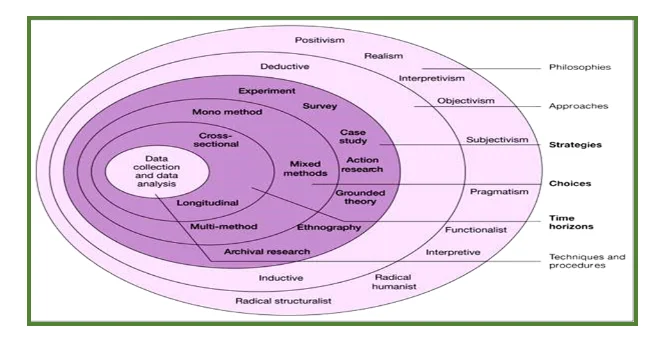
Positivism paradigm defines a worldview to research based on scientific methods of investigation such as experiments, observations and quantitative survey (Saunders et al., 2009). In this way the positivist arrives at generalizable assumptions (ibid). Because of that, the positivist research usually adopts quantitative data collection methods and uses large sample size (ibid).
3.2.1: Realism Paradigm
Saunders et al. (2010) described research realism as a set of assumption where the researcher perceives attributes in a factual and practical manner rather than taking an imaginative perspective. Ideally, the paradigm emphasises on separating reality and practical worlds from imaginative one (Maxwell, and Mittapalli, 2010). Healy and Perry (2000) pointed that realist believe that there are three ontological worlds: First one that is objective consisting of material things. Second world is informed subjective view and it is related to constructivism. Lastly, the third world is built around abstract things. Central to interpretivism paradigm is that the researcher makes every effort to understand and interpret the thinking and meaning the individual is making of the context. Interpretivists argue that individuals are not just react to external social forces but rather are complex entities having different experiences and understanding of ‘objective reality’ (Goldkuhl, 2012). According to Daymon & Holloway (2002) and Gomm (2008), an interpretivist philosophy treats the world as a conglomeration of social constructions and meanings in human engagements and lived experiences. The interpretivist paradigm works in dichotomy with the positivist model, which views the world as an embodiment of clarity, unambiguity, and verifiable reality that can be studied only with total objectivity (Cavana et al., 2001). As such, according to Malik et al. (2013), consumers’ purchasing behaviour is not just subject to marketing and advertising approach but also informed by individual beliefs, reasoning, preferences, and background. Therefore, developing an insight into driving factors of behaving in a certain manners or influence of branding on sales demand understanding underlying factors through the ‘eyes’ of the core players. As such, applicability of mixed approach of positivist and interpretivist perspective.
3.2.1: Pragmatism Paradigm
Pragmatism paradigm rejects the notion that the reality in social science can be accessed by using a single method and, thus, uses multiple methods. It is built around the concept that world variables can be viewed subjectively and objectively. The pragmatist accepts that there can multiple realities that can be scientifically inquired (Tasakkori & Teddlie, 2008). This study into held a believe that product sales and market share is subject to both consumer’s satisfaction with quality of the product, and degree in which it meets consumer expectation. Moreover, external factors such as social parameter held up cultural identity and need to emulate an iconic person or a celebrity have significant influence in purchasing behaviour of consumer. As such, taking pragmatism paradigm driven by need to view relationship between branding and product sales and market share, a case of Air Jordan.
3.3. Research Design
A research design, dictates the direction of the actual study as well as the manner by which the research is conducted (Saunders et al. 2009). According to Remenyi et al. (2003), a suitable research design needs to be selected based on research questions and objectives, existing knowledge on the subject area to be researched, the amount of resources, time available as well as the philosophical leanings of the researcher. The main types of research design are exploratory, descriptive and explanatory design. As pointed by Tetnowski (2015), exploratory research is applicable where a researcher aims to investigate a problem and identify issues that can be focus of future research. According to Sinkowitz-Cochran (2013), in this research approach, the variables are not defined. clearly. Descriptive research takes a format of define and describe phenomenon under research. Lastly, explanatory research design is grounded on offering more insight and understanding of the previously researched problem. The types of strategies that a researcher can adopt include survey, case study, experiment, action research, ethnography, archival research grounded theory, cross-sectional studies, longitudinal studies and participative enquiry (Collis and Hussey, 2009; Saunders et al., 2009). This research followed a descriptive strategy. In relation to time horizon, this study used cross-sectional research rather than longitudinal research due to dissertation submission deadline.
3.4. Research Methods
In order to capture the underlying branding factors influencing the market and degree to which the product brand influence impact sales, a mix research encompassing open- and closed- ended research questions. Griffiths, (2009) points out that the qualitative research design involves detailed exploration and analysis of particular themes and concerns within a topic. Further, he highlights that that qualitative approaches are particularly useful when the topic of research is complex, novel or under-researched as it leaves the results open to the possibility of unexpected findings, rather than predicting an expected outcome as is often the case for quantitative research.
3.5. Research Approach
Research reasoning describes the knowledge development process whether it is a general thinking to specific or vice versa. Zalaghi and Khazaei (2016) contended that a research can develop arguments from either a ‘top-down’ or ‘down-top’ approach through collection of data to develop or confirm established knowledge. Deductive reasoning follows a ‘top-down’ approach where it builds hypotheses based on existing theories and tests cause-effect relationship of variables based on observation and quantitative survey. Whereas, inductive reasoning involves searching for emerging patterns in collected qualitative data to arrive at new hypothesis, formulate inferences and conclusion (Heit, and Rotello, 2010). In the case of this research, numerous studies have been conducted on the branding and marketing strategies outline ways in which they influence product sales and market share. As such, the research employed the use of deductive research approach informed by the exploring the Air Jordan as a brand on the influence products sales and market share.
3.6. Data collection
Within the survey method, researchers can choose between quantitative (questionnaire) and qualitative (interview) approaches Phillips and Stawarski, (2008). Interviews can be conducted either structured, semi-structured or unstructured. The data collection was primary sources through a survey consisting of closed- and open –ended questions. According to Phillips and Stawarski, (2008), survey is efficient due to their ability to capture not only an individual’s opinion, but also their attitudes and beliefs in addition to being they are flexible and easy to fill up in a short time. The questionnaires used contain detailed questions mostly requiring either a Yes or No answer, and in specific limited instances offer ranking scale and/or choices that respondents can easily pick for their response as well as a few open-ended questions for clarification of deep insight points. Gobo (2011) defines population as a group of people, subjects, objects, and/or item that impact an element of the study being taken up and as such, are of interest to the research process. With regards to the aim of the research and considering the objectives and the nature of the information needed, the research specifically focused individuals working in Marketing or Branding fields, a participant population sample of 50 to complete the questionnaire online.
3.6.1: Population Sampling
Sampling is the parameter that enables researchers to select a suitable group of individuals or items from the population for data collection and analysis, consequently as such, influencing the overall research results (Taherdoost, 2016). The most basic sampling methods entail either probability or random sampling, which gives equal opportunity for selection to the entire sample population; as opposed to non-probability or non-random sampling, which requires a specific rationale for the inclusion or exclusion of sample groups of a population (Robinson, 2014; Palinkas et al., 2015). While qualitative methods typically depend upon probability samples that permit confident generalization from the sample to a larger population, the ideas behind a specific sampling approach vary significantly and reflect the research objectives and questions that direct the study (Palinkas, et al. 2015). Knowledge of the range of one’s population and its composition is integral in the determination of whether probability sampling can be implemented (Blaikie, 2010). Random sampling, as pointed by Levy and Lemeshow (2013), is undertaken if a large number of people need to participate in the study to get an unbiased opinion about the subject. However, it is important to target suitable participants in order to analyse data and conduct the survey or interviews for the considered study. Whereas stratified sampling sets a platform allowing participant to work with sample by subcategorize the target population in different subcategories and work with the suitable population category to increase the efficiency of the research outcomes (Robinson, 2014). In a volunteer sampling approach, the research focuses on the individuals to select the population associated with the main theme of the research (Burke, and Murphy, 2011). Here, it is generally called self-selection where the participant voluntarily participates in the study. It is relatively convenient as it helps the researcher to work with informed consent. Largely, applicability of each sampling depends on population sample, research design, and goals of the research. In this case, the population size was potentially huge and hence identifying and selecting the sample needed to be done while avoided biasness, maintaining objectivity, and capturing the wider research aims. In addition, identification of participant followed a randomised online search by searching LinkedIn for individuals in marketing and management field within the UK then sending a request for research participation. The participants of this research were invited to fill the questionnaire online via OnlineSurveys, an online researching platform. The invitation process was subject to background knowledge or experience in marketing and/or management dealing with products sales and market.
3.7: Data Analysis
As pointed the research adopted a quantitative research informed by an open- and closed ended questions, online survey. In analysing the acquired responses was informed by aim of capturing the respondents view of branding. Thematic analysis is the main tool for analysis for the primary data collected through the questionnaires issued to respondents. According to Braun and Clarke (2006), thematic analysis is a qualitative research method of analysis that takes into account the identification, analysing and reporting of patterns, themes, and connections available within raw data. Descriptive analysis, as pointed by Thompson (2009), captures a summary of collected data in statistical manner. Through the use of the data collected through a wide variety of different research methods questionnaires as applied in this research study, accurate and replicable inferences can be made from the analysis of the various patterns and themes to further explore various energy efficiency design techniques consumers prefer in the construction of energy efficient and comfortable housing. The data collected from online survey was examined before drawing patterns based on participants’ responses on regarding relationship branding, and product brands and sales and market share drawn statistically.
3.8: Ethical consideration
Fundamentally, any research involving human beings or living things as subjects must adopt moral standards aimed not to cause any harm physically or emotionally to the participants (Hammersley, and Traianou, 2012). In academic research, ethical standards outlined in the code of conduct need to be observed and adhered to while acquiring, analysing, presentation, and storage of data as well as reviewing literature (Wester, 2011). In that note, the researcher has sent consent letter and ethical form outlining the scope, extent, and usage of the collected data to the potential participants. It made sure the participants understood the purpose of the research, the problem aimed to address, and scope of the research in addition to ensuring confidentiality and privacy would be prioritised and upheld during data collection, analysis, and storage. The procedures and consent letter were attached to the invitation sent to potential participant through social media platforms and emails, and their participation in filling the questionnaire meant their consent to the research. Additionally, in order to ensure integrity at both academic and social levels, the research emphasised on referencing and citing any information used either literature or primary data accordingly. It also upheld the university guidelines and Britain policy on conduct research and handling personal data and information that include signing ethical form before commencement of the research and emphasising privacy and confidentiality of the participants.
Limitation
Understanding the influence of branding on product sales and market share calls on understanding the underlying factors such as consumer relation with the product. The quantitative research employed through questionnaire data collection did not delve deeper into underlying factors.
Chapter 4: Findings and Analysis
Chapter Introduction
In data collection, this research used data from primary sources. The data collection process involved sending invitation for participation to potential participants and following with a link to online survey platform hosting the questionnaire. A open- and close ended questionnaire covering the participants demographic, knowledge on branding, opinion on the influence of branding on sales and market share, and view on whether Air Jordan brand has benefited from branding strategy by Nike Inc. The data collected was tabulated and patterns drawn to form themes. This findings chapter outlines the data collected and subsequently the analysis and presentation captured under key themes as expressed by the participants.
Participant Demographic
Although initially the research population size was set to be 50 individuals, only 17 participants responded and participated in the survey by filling the online questionnaire. From Table 4.1 below, the participants’ occupation and company affiliation varied. Similarly, 15 of the 17 participants indicated brands associated with the company affiliated to, although after cross-checking brands specified against the companies indicated by the participants show most no direct links such as a product of the respective companies. Therefore, assumption would be the participants specified brands which the companies they held association either working with or working for, for instance, link between LinkedIn and Ministry of Justice.
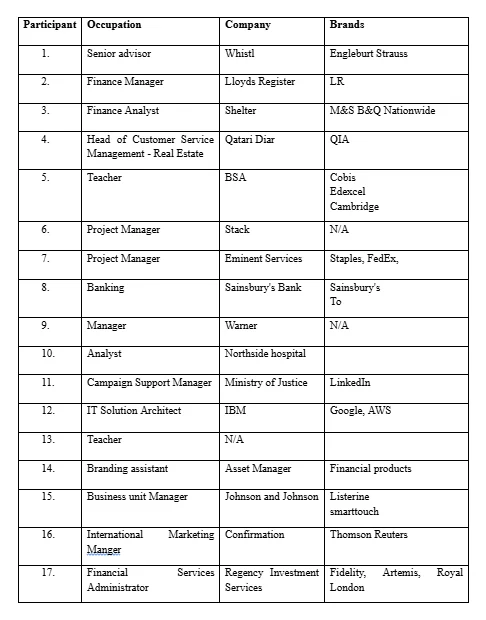
Experience in marketing department
As shown in the Figure 1, on question of whether participants had worked in marketing before or currently working in the department involved with marketing and branding, all of the 17 participants acknowledged with eight indicating working there for between 0-2 years, seven participants indicating having 2-5years experience, and one participant indicating 10+ years working in working in marketing.
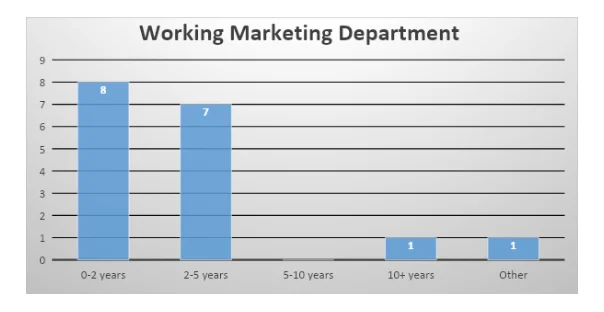
Branding as a Marketing strategy
The survey asked the participants whether branding as marketing strategy by respective companies. The 10 participants, approximately 63%, indicated branding hold a significant influence acting as a major marketing strategy for the respective companies. However, 5 participants approximately 31.3% indicated otherwise implying branding would not be considered a major marketing tool for the respective companies.
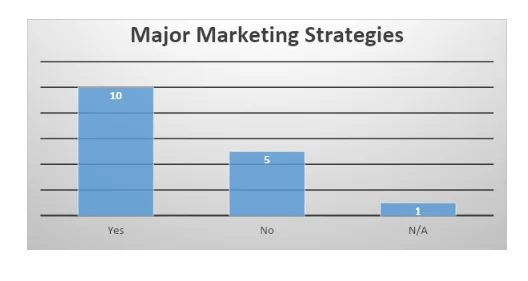
Factors Considered in Branding Process
In order to determine the factors considered in implementation of branding as a marketing strategy, the questionnaire listed six options to capture participants’ perspective. The participants where not limited to selecting a single factor but multiple. As indicated by the graph, the majority of the participants (62.5%) indicated targeting audience was a driving force followed by exposure and consistency (56.3%). Half of the participants (8) who responded to the questions selected brand value and purpose while seven (43.8%) pointing that marketing methods and materials, and unique value proposition held same degree of consideration.

Benefits Associated with Branding
The question was drafted in semi-structured approach with multi-selection options and platform for those holding alternative opinion to express so in writing. The findings indicate 75% of the respondents held product branding increased visibility in the modern market while 50% perceived it maintained and improved organization reputation. Seven participants a representation of 43.8% of the respondent pointed that by branding a product, it attracts new generational customers, increased business value, and creating trust with the customers (Figure 4). Only 1 participant expressed held opinion other than those outlined in selection section stating that branding “Helps you stand out in a saturated market, builds a reputation, and leads to returning customers and referrals”.
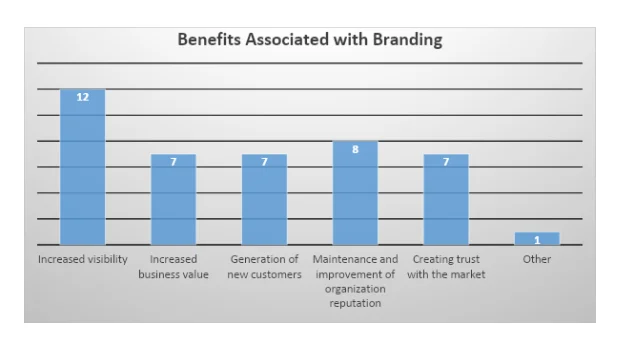
Product branding influence on market performance
On the question of whether branding influences a product performance in a market, the participants were given an option to picking more than one answer but required to explain their response if they selected ‘Yes’. From the Figure 5, all the respondents to the questions indicated branding influences product market performance. However, 66.7% of the participants also selected the ‘No’ answer while 33.3% also selected ‘Others’.
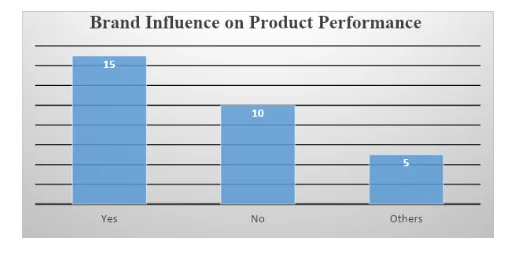
For the participants who specified their views stated, “Very well branded products can have a positive affect on a products market performance”. Another participant stating, “Yes, awareness is key in a society of hyper reality and extreme attention deficit” while another holding that “Reputation says a lot”.
Branding Negative Impact on a Product
15 of the 16 respondents held that product branding could have a negative impact on a product and ultimately a company with only 1 person indicating that branding cannot influence negatively a product performance.
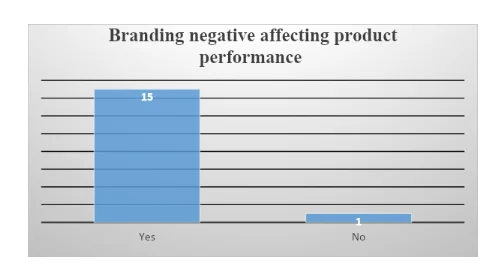
In selecting ‘Yes’, the respondents were requested to explain their responses. As shown on Table 4.2, the participants held views that products branding have potential of putting potential consumers off making them disinterested. The prevalent response indicated negative publicity or bad reputation associated with the brand, for instance, one participant gave the Tiger Hoods scandals, which may have put the products associated with him in bad imagery. If a celebrity acting as the face of a products in caught in scandals can significant affect the reputation and perception held by the consumes towards the product. Additionally, other participants argued that not getting the brand right that is not resonating and connecting emotionally with target demographic could have negative repercussions and leading the audience turning against the product. As showing in Table 4.2 below, other branding factors that would affect a product negativity include excess branding, negative press, and affiliation.

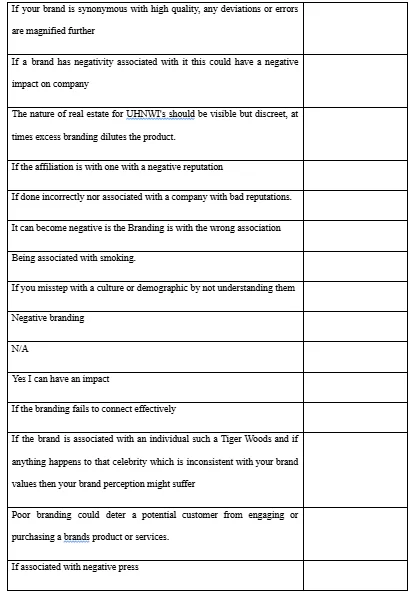
Branding Impacted Sales and Market Share: Nike Air Jordan
All the respondents on whether branding approach taken by Nike Air Jordan has resulted in increase in products sales and market share indicated either ‘Increased’ or ‘Maintained’. From the findings (Figure 7), 70.6% of the respondents indicated branding caused increase in the products sales and market share while 52.9% pointed to approach resulted in sustainability.
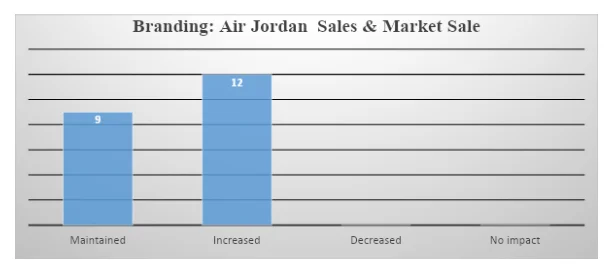
Explaining the ways in which Nike-Air Jordan has benefitted from branding, the respondents listed visibility, reputation, brand identity, consistency, logo synonymous with success, cultivating cultural identity, product exposure, and celebrity effect as key elements. One participant indicating the infield NBA sporting performance by Michael Jordan “The logo is synonymous with success and the epitome of a champion in sports for 20 yrs +”
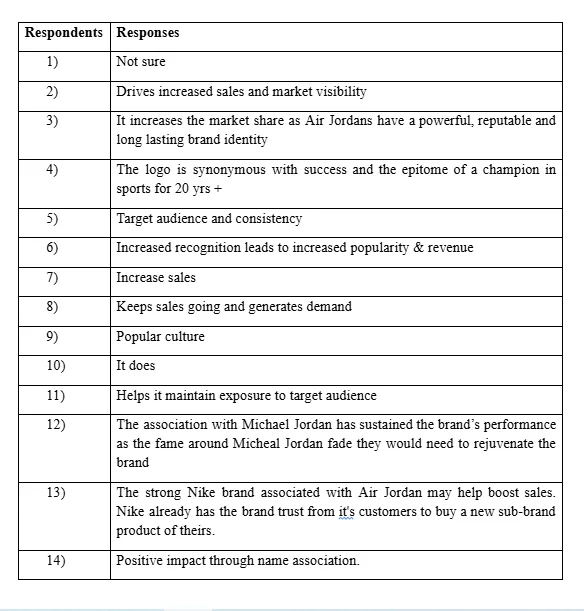
Altering a brand: Enhance value and Market share of a product
From the Figure 8 below, all the respondents to the question selected that altering branding approach have a potential of enhancing the sales and market share with 14 respondents (82.4%) indicated that changing a brand is effective while 1 (5.9%) and 3 (17.6%) indicating quite effective and very effective respectively in enhancing the value and market share of a product.
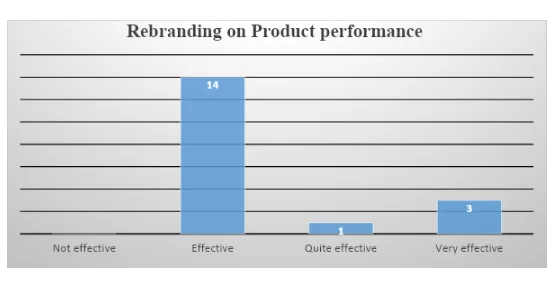
Alternatives Marketing Approach to Branding
Surprising, 70.6% of the respondents claiming the Nike Air Jordan had not alternative to branding as marketing approach with only 29.4% indicated existence of different approach with similar product market performance.
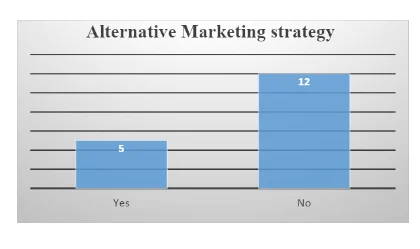
For the participants indicating the company can implement a different approach pointed such techniques as ‘Advocacy and Social Media Marketing’, ‘Quality of the Product’, and ‘Product Placement with Influencers’
Chapter 5: Discussion
Branding, as highlighted by Markus (2019), refers to the process of developing and creating a positive and strong perception of an organization or company that include the products and services in the mind of the consumer. Hestad (2016) described product brand as a distinguishing factors separating a given products from others in the market developed by creating a unique name and image in consumer mind through maintaining consistent theme. From the findings, product-branding enables a company differentiate products offered from those vast numbers available in the market. The uniqueness of the product gives it an identity within the marketplace (Hoberg, and Phillips, 2014; Apostolakis et al., 2015). Particularly, in modern market morphed by stiff competition, and heighten pressure and difficulty in meeting consumer demands and preferences have prompted business to explore the concept and approach of standing out by being different and having an identity within the marketplace (Boone and Kurtz, 2013). Williams (2018) cites a study by Zendesk on consumer behaviour concerning brands highlighting that 87% of consumers said consistent branding across all online and traditional platforms is important for the development of a business identity. Eventually effective branding helps companies differentiate themselves from their competitors and build a loyal customer base. Nevertheless, as pointed out by Abbing (2010) and Stompff (2008), brand development is not just about logos, design, messaging, names and descriptions, and packaging but entails emotional connections with the consumers. Schmitt (2012) argued that consumers seek connection with a product they consume and, at large, a company. A research seeking relationship between user-generated content (UGC) and shopping behaviour focusing on the personal connections, authenticity, and brands strategies revealed a sharp rise in the average conversation about the product or the company and revenue by best-in-class brands (Malthouse et al., 2016). Currently, businesses have increasingly adopted data generated from consumer preferences aimed to model and develop products best-fit and connect with consumer unique needs and values (Linoff, and Berry, 2011; Richardson et al., 2015). Survey conducted by Liu et al. (2017) show that consumer-centric products informed by realisation that consumers control the market built are conversation around services and products rather than businesses determining the relationship. Building from the findings by Wear et al. (2018) on rebranding on NBA, re-imagine of a brand supported by such strategies as effective communication, creating identity, and connecting emotionally with the consumers, NBA fans, have a significant effect on market share and product sales. Over the years, Nike Inc. has combined unique techniques such as competencies and capabilities to positing itself as a sustainability leader (Epstein et al., 2010). The participants were asked about the significance of branding in contemporary aimed at highlighting development of brand identity, consistency, visibility, and using prominent personality synonymous with success and ‘greatness’. The participant claim that branding enhance visibility is supported by the findings by Erdem et al. (2016) noting that branding in the era of social media has taken a multifaceted perspective, a branded product is noticeable easy meaning social media users can easy spot unique and stand out product. However, in event that a brand imagery is associated with scandals or attract negative publicity it would lead being perceived in a negativity perspective that ultimately hurt sales and market share.
Among other approaches such as product innovation, streamlining the manufacturing process, product quality and services efficiency, and adoption of social media to reach out to consumers, according to Kumar & Christodoulopoulou (2014) and Jin & Yazdanifard (2015), branding of the products has recently been seen as most important technique to market success. Significant number of participants claimed that although product branding tend to connect more with participants, adopting such approaches as product consistency and social media marketing to reach out to consumers and potential customers would enhance product sales and market share. The company developed a significant unique ‘Jump man’ logo for the brands, which has remained the same since its creation maintaining its emotional impact to consumers to the current contemporary market. In designing Air Jordan 1, team of 14 designers with unique background and personality were involved aimed at incorporating different perspective that include ‘strength’, sport enthusiast, and ‘street-style’ wear in development process and product (Petrina, 2000). Scott (2020) highlights that teenagers and individuals who were not even alive at the time of the development of the brand and the logo associate it to success due to the success story and legacy of Michael Jordan behind it. As pointed by the findings, The emotional attachment of the brand to the consumer market as such is the single most significant aspect of the brand that grants it competitive advantage over other brands impacting significant sales and market share in the contemporary market.

Chapter 6: Conclusion
This study aimed at understanding the place of branding in modern business market examining the influence branding on product market share and sales. As such, outlining the relationship between products brand (Air Jordan) and sales/product sales as well as understanding underlying whether such factors such as brand loyalty and brand experiences play a critical role on the product sales. Therefore, it adopted both interpretivist and positivist perspectives under pragmatism paradigm taking objective and subjective constructs. The quantitative research approached enabled capturing quantifiable relating to branding and product market performance. Using online survey, 17 participants responded and completed filling the questionnaire on product branding. Ideally, rebranding involving giving a product new attributes name, design, concept, identity, and connecting with target consumer enables a company restructure its consumer bases and if done accordingly tapping the emotional connection with target customers, enhance sales. Consumers purchasing behaviour has changed where most explore for commodities that they can associate with and relate as well as need to be part of something bigger. As such, business entities have shifted to using celebrities such sporting personalities (Tiger Hoods, Lebron James, and Cristiano Ronaldo sponsored and face of Nike; Messi and Pogba sponsored and face Pepsi and Adidas products), musicians, movie stars, and through endorsement and face a major brands. From the findings, in the contemporary market, Nike has over years significantly benefited from Air Jordan brand and related imagery in which it has developed a brand identity, consistency of products, connected with consumers, and brand loyalty.
Research Strength and Weakness
In order to develop an in-depth analysis of how branding has impacted the sales of Air Jordan significantly clarifies the relationship between branding and market performance of products the participants were requested to given filling a semi-structure questionnaire with some instances given options to pick from. This research approach may have suffered from leading the participants to answers by giving then response to pick from. For instance, question 11 was worded to suggest the participants such that has prior knowledge of sales and market performance of the Nike Air Jordan product and does not leave an option for those with no knowledge in this area - results may therefore be skewed slightly. In some instances, the participants may have not known the product in question but the questions did not leave an option for those with no knowledge in this area. As such, should have question prior to ask if the recipient has knowledge on the product to increase data accuracy. This may have skewed the findings and limiting objectivity by not giving a correct perspective of the participants’ opinion on factors and influence of branding.
Future Studies
Based on the findings and weaknesses encountered during the research, the following are recommendation of future studies:
In order to capture the negative influence of Air Jordan branding on market share and sales, there is need for in-depth understanding through interview
The interview should be strictly restricted to individuals with prior knowledge of Air Jordan the product and Nike marketing strategy
References
Aaker, J.L., 1997. Dimensions of brand personality. Journal of marketing research, 34(3), pp.347-356.
Abbing, E.R., 2010. Brand driven innovation: Strategies for development and design (Vol. 21). Ava publishing.
Abdul-Hamid, I.K., Hinson, R.E., Mahmoud, M.A. and Yaw, E., 2017, June. Sustainability Marketing: The 7ps Perspectives. In 5 th International Conference on Contemporary Marketing Issues ICCMI June 21-23, 2017 Thessaloniki, Greece (p. 595).
Agyekum, C.K., Haifeng, H. and Agyeiwaa, A., 2015. Consumer perception of product quality. Microeconomics and Macroeconomics, 3(2), pp.25-29.
Agyemang, K.J., 2012. Black male athlete activism and the link to Michael Jordan: A transformational leadership and social cognitive theory analysis. International Review for the Sociology of Sport, 47(4), pp.433-445.
Al-Abdallah, G.M. and Abo-Rumman, A.H., 2013. The effect of brand associations on customer loyalty: Empirical study on mobile devices in Jordan. American Academic & Scholarly Research Journal, 5(1), p.122.
Alazzawi, A., 2019. Brand personality dimensions of Nike sportswear -an empirical analysis. Journal of Business and Retail Management Research, 13(4), pp.103-114.
Anselmsson, J., Bondesson, N.V. and Johansson, U., 2014. Brand image and customers' willingness to pay a price premium for food brands. Journal of Product & Brand Management.
Archer, L., Hollingworth, S. and Halsall, A., 2007. University's not for Me—I'm a Nike Person': Urban, Working-Class Young People's Negotiations ofStyle', Identity and Educational Engagement. Sociology, 41(2), pp.219-237.
Arsena, A., Silvera, D.H. and Pandelaere, M., 2014. Brand trait transference: When celebrity endorsers acquire brand personality traits. Journal of Business Research, 67(7), pp.1537-1543.
Bastos, W. and Levy, S.J., 2012. A history of the concept of branding: practice and theory. Journal of Historical Research in Marketing.
Boonpradub, W. and Thechatakerng, P., 2015. Brand endorsement by celebrity in Thailand: 7Ps of marketing mix and the impact of brand alliance. International Journal of Trade, Economics and Finance, 6(1), p.8.
Burke, Ó. and Murphy, P., 2011. The use of volunteer radon measurements for radon mapping purposes: an examination of sampling bias issues. Journal of Radiological Protection, 31(3), p.319.
Davcik, N.S. and Sharma, P., 2015. Impact of product differentiation, marketing investments and brand equity on pricing strategies. European Journal of Marketing.
Domanović, V., 2013. The effectiveness of the performance measurement in terms of contemporary business environment. Ekonomski horizonti, 15(1), pp.31-44.
Dwivedi, A., Nayeem, T. and Murshed, F., 2018. Brand experience and consumers’ willingness-to-pay (WTP) a price premium: Mediating role of brand credibility and perceived uniqueness. Journal of Retailing and Consumer Services, 44, pp.100-107.
Elliott, G.R. and Cameron, R.C., 1994. Consumer Perception of Product Quality and the Country-of-Origin Effect1. Journal of international Marketing, 2(2), pp.49-62.
Gakure, R., Keraro, V., Okari, H. and Kiambati, K., 2012. Emerging trends shaping contemporary business strategy. Prime Journal of Business Administration and Management, 2(9), pp.673-679.
Garanti, Z., 2019. Ethical Brand Perceptions and Their Impact on Brand Loyalty and Brand Choice Intentions: Mediating Role of Emotional Brand Attachment. Journal of Yasar University, 14(56).
Hammersley, M. and Traianou, A., 2012. Ethics and educational research. London: British Educational Research Association.
Han, O.W. and Yazdanifard, R., 2015. The Review of the Effectiveness of Celebrity Advertising that Influence Consumer’ s Perception and Buying Behavior. Global Journal of Management and Business Research.
Healy, M. and Perry, C., 2000. Comprehensive criteria to judge validity and reliability of qualitative research within the realism paradigm. Qualitative market research: An international journal.
Hoberg, G. and Phillips, G.M., 2014. Product market uniqueness, organizational form and stock market valuations. Organizational Form and Stock Market Valuations (August 31, 2014).
Janiszewska, K. and Insch, A., 2012. Th e strategic importance of brand positioning in the place brand concept: elements, structure and application capabilities. Journal of International Studies, 5(1), pp.9-19.
Kellner, D., 2001. The sports spectacle, Michael Jordan, and Nike: unholy alliance. Michael Jordan, Inc.: Corporate sport, media culture, and late modern America, pp.37-63.
Kunkel, T., Doyle, J. and Funk, D., 2014. Exploring sport brand development strategies to strengthen consumer involvement with the product – The case of the Australian A-League. Sport Management Review, 17(4), pp.470-483.
Laub, F., Ferdinand, H.M., Kramer, I. and Pätzmann, J.U., 2018. How archetypal brands leverage consumers' perception: A qualitative investigation of brand loyalty and storytelling. Markenbrand, (6/2018), pp.46-54.
Loureiro, S.M.C., 2013. Consumer-brand relationship: Foundation and state-of-the-art. In Customer-centric marketing strategies: Tools for building organizational performance (pp. 414-434). IGI Global.
Malthouse, E.C., Calder, B.J., Kim, S.J. and Vandenbosch, M., 2016. Evidence that user-generated content that produces engagement increases purchase behaviours. Journal of Marketing Management, 32(5-6), pp.427-444.
Martin, I., Stewart, D. and Matta, S., 2005. Branding Strategies, Marketing Communication, and Perceived Brand Meaning: The Transfer of Purposive, Goal-Oriented Brand Meaning to Brand Extensions. Journal of the Academy of Marketing Science, 33(3), pp.275-294.
Maxwell, J.A. and Mittapalli, K., 2010. Realism as a stance for mixed methods research. Handbook of mixed methods in social & behavioral research, pp.145-168.
McKelvey, S., Goins, J. and Krauss, F., 2015. The Air Jordan Rules, Image Advertising Adds New Dimension to Right of Publicity-First Amendment Tension. Fordham Intell. Prop. Media & Ent. LJ, 26, p.945.
Palinkas, L.A., Horwitz, S.M., Green, C.A., Wisdom, J.P., Duan, N. and Hoagwood, K., 2015. Purposeful sampling for qualitative data collection and analysis in mixed method implementation research. Administration and policy in mental health and mental health services research, 42(5), pp.533-544.
Popp, B. and Woratschek, H., 2016. Consumer–brand identification revisited: An integrative framework of brand identification, customer satisfaction, and price image and their role for brand loyalty and word of mouth. Journal of Brand Management, 24(3), pp.250-270.
Pradhan, D., Duraipandian, I. and Sethi, D., 2016. Celebrity endorsement: How celebrity–brand–user personality congruence affects brand attitude and purchase intention. Journal of Marketing Communications, 22(5), pp.456-473.
Seyedghorban, Z., Matanda, M.J. and LaPlaca, P., 2016. Advancing theory and knowledge in the business-to-business branding literature. Journal of Business Research, 69(8), pp.2664-2677.
Stanfel, R., 2000. Nike, Inc.: Air Jordan campaign. Encyclopedia of Major Marketing Campaigns, 1, pp.103-114.
Su, J. and Tong, X., 2015. Brand personality and brand equity: evidence from the sportswear industry. Journal of Product & Brand Management.
Taylor, P.C. and Medina, M., 2011. Educational research paradigms: From positivism to pluralism. College Research Journal, 1(1), pp.1-16.
Tsai, S., 2006. Investigating archetype‐icon transformation in brand marketing. Marketing Intelligence & Planning, 24(6), pp.648-663.
Vanclay, F., Baines, J.T. and Taylor, C.N., 2013. Principles for ethical research involving humans: ethical professional practice in impact assessment Part I. Impact Assessment and Project Appraisal, 31(4), pp.243-253.
Wear, H., Collins, D.R. and Heere, B., 2018. What‘s in a name? A case study of NBA basketball in Charlotte. Sport Marketing Quarterly, 27(2), pp.1-26.
Yazdanifard, R. and Jin, O., 2015. The Review of Contemporary Branding Techniques that can Influence Current Consumer Buying Behavior. Global Journal of Management and Business Research, 15(6), pp.59-63.
Zalaghi, H. and Khazaei, M., 2016. The role of deductive and inductive reasoning in accounting research and standard setting. Asian Journal of Finance & Accounting, 8(1), pp.23-37.
- 24/7 Customer Support
- 100% Customer Satisfaction
- No Privacy Violation
- Quick Services
- Subject Experts



